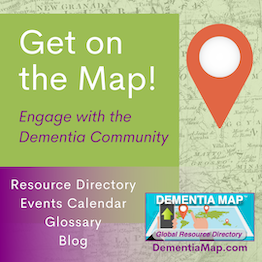Memory Cafe Directory posts and/or links to retailers can be advertising, sponsored, or affiliate links. We may earn a small commission from them. Thank you.
Getting out of a chair and walking to the kitchen for a snack is no big deal for most people. It’s so ordinary that we do not even consider mobility a gift. For older adults, routine, everyday things become more and more difficult for us to do. This can of course impact our quality of life – not to mention the underlying health concerns.
Joint problems, muscle pains, and other physical issues can make it very hard to move around as freely as we once did. This can be when most people look for ways to stop the progression of existing health issues. Alzheimer’s Disease or other types of dementia can be one of those issues.
Let’s look at the connection between dementia and one’s mobility, and explore ways to tackle these challenges in a healthy and sustainable manner.
Dementia and Limited Mobility
Dementia can affect brain areas that deal with muscle coordination and balance. For older people who already experience mobility issues, this can create an additional problem. (Not to mention the related frustration!)
How can these problems be resolved? You could get a physical therapist involved, but the easy answer is regular exercise. No, we do not mean intense exercise programs and strenuous activities that only young people can do.
Light and easy exercises can go a long way in helping seniors with dementia control their movements, build some muscle strength, and improve their balance. This can help make everyday tasks just a bit easier, improve their outlook, and be a positive contribution to their quality of life.
Risk Factor: Chronic Disease
Loss of mobility for long periods of time can put elderly individuals at an increased risk for chronic health conditions like heart disease and other health problems. A healthy diet and an appropriate physical activity program can be a deterrent to developing chronic conditions. With an increased population age, strength training, joint mobility, and improved energy levels can be some of the most important tools for avoiding a hospital environment.
Whether it is professional in-home caregivers or family members caring for a loved one, a major challenge can be to identify the proper types of exercise. A systematic review of what’s available can avoid adverse affects and loss of independence by choosing the right set of exercises for the person in your care.
Targeting Key Exercises
There are many targeted exercises that can help teach seniors how to strengthen lower back muscles, how to improve posture, how to improve their gait, and so on. Many of these exercises can also be done while seated. These exercises will improve cardiac function, reduce anxiety and depression, and lower the rate of cognitive decline.
It really doesn’t take a large number of exercises and routines to make a big difference. It simply takes strategically targeted ones to maximize the benefits, while minimizing the risks. Let’s look at the four exercises that can help increase mobility changes through improved range of motion for seniors living with dementia.
1Yoga
Yoga is one of the best ways for seniors with dementia to maintain their well-being and mobility. Yoga targets every part of the body and has not just physical benefits, but psychological ones, too. It helps you feel better in any number of ways!
If you are new to Yoga, going online can help you look for many easy Yoga postures and exercises which are safe for beginners. If you are familiar with Yoga or have experience with it in the past, you have an expanded set of options. In either case, it is a very good idea to ask your doctor which poses and moves are right for you and your medical condition before you start.
One of the most important physical benefits of Yoga is that it improves flexibility and agility, something that goes away with both increasing age as well as the onset of dementia. Yoga can help in boosting cardiovascular health if done at a brisk pace while doing it at a slow pace can help with mindfulness. Either way, it can improve physical function and should become part of a daily routine.
Yoga helps improve bone strength, can prevent falls, and contributes to better circulatory health. It also helps in reducing anxiety and stress, improves sleep quality, and helps reduce the rate of cognitive decline. Family members can participate as well as a great way to enjoy a fun daily exercise routine for all.
If you feel Yoga might be too monotonous, you can try Tai Chi. This is similar to Yoga but should be taught by a trained and experienced practitioner. The physical abilities of the participant must of course be considered carefully.
2Seated Exercises
Seated exercises (often called chair exercises or chair yoga) are equally important in the management of dementia. These exercises can be performed practically anywhere, and at any time. They can be done individually, in small groups, or even in large communities.
Seniors with dementia will certainly enjoy health benefits from doing these seated exercises, either as a class or individually. These exercises are aimed at improving balance and building strength for everyday activities. They are much less strenuous than standing exercises, hence these are perfect even for those who are much older or might already have mobility problems.
Here are some examples of seated exercises that can help individuals with dementia:
- Practicing moving from standing to sitting
- Raising the arms towards the ceiling
- Clapping under the legs
- Bending the legs
- Bicycling
- Raising the heels and toes
- Stretching the legs
- Making circles with arms and legs
- Turning the upper body from one side to another
While these exercises sound easy, it is always advised to have them demonstrated by a trained professional before trying them out. Start with slow, smooth motions to get everything “loosened up.”
In a group setting, maybe in care homes, community activities like this sort of new exercise program can have a significant impact on social interaction. Participating residents who spend time together addresses the needs of an individual to stay connected to others.
3Swimming
Swimming is one of the healthiest activities anyone can do. For seniors with dementia, activities in the swimming pool can help build strength and resistance, while improving balance.
Many people find the sensation of being in the water soothing and relaxing. Swimming exercise as a regular physical activity can be the best option to also help reduce the risk of falling. It can build muscle mass which contributes to overall physical fitness in elderly people.
Swimming activities should always be performed under strict supervision and in shallow waters.
Some easy swimming exercises are:
Water Walking
This is one of the most useful swimming activities. Walking in chest-deep water is a form of resistance training and can help in improving strength. It simply takes more energy to walk in water than it does on land. Resistance without the resistance bands. It is an excellent lower body workout, but in a controlled manner. It can be a very appropriate cardiovascular exercise.
Mini Squats
For people who are nervous about doing proper squats, mini squats in waist-deep water while holding the railing or the side can be a great alternative. This builds lower back strength and strengthens the legs. This motion builds lower body strength, which in turn can reduce the risk of falls.
Leg Swings
Another easy exercise to do in the swimming pool is swinging your leg like a pendulum from side to side while holding onto the railing or the side for support. It takes greater strength to move the legs in the water, and this helps in building strength and improving overall physical health.
If this is a bit too much, just do Leg Lifts. When standing in the pool, lift one leg to the side and then back to a standing position. This can be a good starting exercise, eventually graduating to the full Leg Swings.
Flutter Kicks
By holding onto a floating kickboard, participants can feel a sense of progress by simply kicking their legs to propel them through the water.
Arm Circles
With the water up to the participants’ necks, they can spread their arms out to the sides. Start moving in small circular patterns. As the ability increases, use the palms to add resistance and/or make larger and larger circles.
Arm Curls
With arms at their sides, participants bend their arms, raising their hands to their shoulders. An open hand adds resistance as the ability improves. If more resistance is needed, water weights can be used. These are small dumb bell type devices designed for use in a pool.
Chest Curls
With your arms in front of you, place your palms together, like you’re clapping. Then, push your arms out to the sides – and back – using the water as resistance. Don’t overdo it, but expand the arms as much as possible. Not only does this act as resistance for strength purposes, expanding the arms and chest with this motion can help improve overall range of motion.
All these swimming activities together will help in improving overall mobility for seniors with dementia. They can also have a positive influence on maintaining a healthy weight, lower blood pressure, and for overall disease control.
If your pool happens to be outside, it becomes a fun way to get a little extra Vitamin D as well!
4Exercises for Grip Strength
With the onset of mild cognitive impairment, a lot of seniors experience a reduction in grip strength and muscle control. This reduced ability is because the areas of the brain associated with grip and hand movements also play a role in higher cognitive function.
Practicing grip strength exercises will help in strengthening the muscles in the arms as well. Moreover, these exercises will also improve hand-eye coordination and lead to an overall increase in fitness.
The best way to practice grip strength exercises is to use a stress ball. It can be done regardless of a person’s ability, and of course can be also be done in a seated position. Follow these directions to use a stress ball for improving grip strength:
- Place the stress ball on the palm of the hand and squeeze it for 5 seconds, and then relax.
- Repeat this about 10-15 times.
- Place the stress ball between any finger and the thumb, press for 5 seconds, and then relax.
- Do this with any finger to improve the grip of the fingers.
Safe But Effective
When performed properly and with proper supervision, these exercises can be quite safe for nearly any physical condition level. They can also play a vital role in improving cognitive function in seniors with dementia. Exercise in general increases blood flow to the brain, can have a positive impact on high blood pressure, promotes better sleep, and leads to a lesser incidence of depression and other mental health issues.
As mentioned previously, these exercises can help improve balance and gait while reducing the risk associated with falls. They help seniors with dementia maintain their overall physical independence, their success with activities of daily living, and can deter mobility loss for a longer period of time.
Mobility aids are of course helpful in preventing falls and maintaining one’s sense of independence in the face of the adverse effects of cognitive decline. However, a safe and effective exercise regimen can be a significant dependent variable in maintaining or improving one’s quality of life. A good barometer of that successful progress is a potential reduction in the reliance of those aids.
A state of the art fitness center is not required for exercise be a very positive factor in improved mobility. Any safe, comfortable space with good lighting can be very effective. What is important is a combined approach of physical and cognitive therapy – applied in appropriate ways as part of their daily activities. It can help seniors with dementia live longer, more fulfilled lives.









